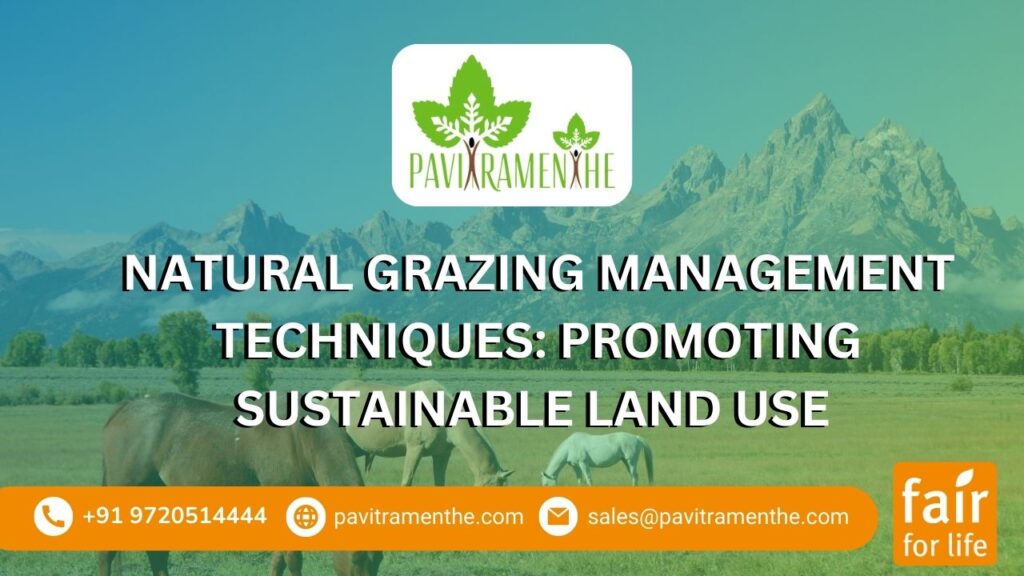Natural grazing management techniques
these are essential tools for promoting sustainable land use and ensuring the long-term health and productivity of grazing ecosystems. These practices aim to mimic the natural grazing patterns of herbivores, allowing for optimal forage utilization, soil health improvement, and biodiversity conservation. By employing these techniques, land managers can optimize livestock production while minimizing environmental impact and enhancing overall ecosystem resilience. In this article, we will explore some key natural grazing management techniques and their benefits.
Rotational Grazing: Rotational grazing involves dividing pastures into smaller paddocks and moving livestock periodically from one paddock to another. This technique allows for adequate forage rest and regrowth, preventing overgrazing and promoting healthier pasture conditions. Rotational grazing provides numerous benefits, including improved forage quality, enhanced nutrient cycling, reduced weed proliferation, and increased stocking rates. Moreover, it helps prevent soil erosion, improves water infiltration, and encourages the establishment of diverse plant species.
Rest and Recovery Periods: Including rest and recovery periods in grazing management plans is crucial for maintaining the long-term health of grazing lands. Rest periods allow forage plants to regenerate, rebuild their root systems, and increase carbohydrate reserves, resulting in stronger and more resilient vegetation. This practice also promotes the growth of desirable plant species, reduces the dominance of weeds, and improves overall forage quality. By strategically implementing rest and recovery periods, land managers can support the sustainability of grazing systems.
Targeted Grazing: Targeted grazing involves using livestock to manage specific vegetation types or control invasive plant species. By selectively grazing on certain plants, livestock can help control their growth and spread, reducing the need for chemical herbicides. Targeted grazing is particularly effective for managing brush, weeds, and other undesirable vegetation. This practice not only enhances forage availability for livestock but also promotes biodiversity by creating opportunities for native plant species to thrive.
Water Development and Distribution
it Ensuring adequate water availability and distribution across grazing lands is vital for successful natural grazing management. Water sources should be strategically located to encourage even grazing distribution and prevent overgrazing near water points. By properly managing water resources, land managers can reduce soil erosion, maintain plant vigor, and enhance overall animal performance. Additionally, providing access to clean drinking water for livestock promotes their welfare and productivity.
Monitoring and Adaptive Management: Regular monitoring of grazing lands is essential for evaluating the effectiveness of management practices and making necessary adjustments. Monitoring can involve assessing forage utilization, plant species composition, soil health indicators, and livestock performance. By closely observing these factors, land managers can implement adaptive management strategies, making informed decisions to optimize grazing systems over time.
Benefits of Rotational Grazing:Rotational grazing, also known as managed intensive grazing or cell grazing, is a system where livestock are moved regularly between different grazing areas or paddocks. This method offers several benefits for both the animals and the land. Here are some of the advantages of rotational grazing:
Also Read-Holistic Herbology hub
Improved forage quality: Rotational grazing allows for better management of forage growth and regrowth. By moving livestock to different paddocks, the animals have access to fresh, high-quality forage, while the previously grazed areas get time to recover and regrow. This leads to improved nutrition for the animals, as fresh forage is more nutrient-dense compared to mature or overgrazed plants.
Increased carrying capacity: Efficient rotational grazing systems can increase the carrying capacity of a pasture. By dividing the grazing area into smaller paddocks and implementing a rotation schedule, the land can support more livestock without causing overgrazing. This helps maximize the productivity and profitability of the grazing operation.
Soil health and fertility: Rotational grazing can benefit soil health and fertility. When animals are moved regularly, their manure is distributed more evenly across the pasture. This promotes nutrient cycling, as the manure acts as natural fertilizer, enriching the soil with organic matter and essential nutrients. Additionally, the rest periods between grazing allow the grasses to develop healthier root systems, improving soil structure and water infiltration.
Weed and pest control: Rotational grazing can help manage weeds and pests more effectively. Grazing animals tend to selectively graze certain plant species, which can reduce the dominance of undesirable or invasive plants. Additionally, the trampling effect of livestock can suppress weed growth. By managing the grazing intensity and timing, rotational grazing can be used as a tool to control weeds and pests without the need for excessive herbicide or pesticide use.


Biodiversity and wildlife habitat: Properly managed rotational grazing systems can enhance biodiversity and provide habitat for various wildlife species. The diversity of grasses and plants in a rotational grazing pasture can support a wide range of insects, birds, and small mammals. This can contribute to a healthier ecosystem, including pollinators and beneficial insects that help control pests.
Reduced soil erosion and runoff: Rotational grazing helps mitigate soil erosion and reduces runoff compared to continuous grazing. By resting grazed areas, the vegetation cover can recover and provide better protection against water erosion. The increased organic matter in the soil resulting from rotational grazing also improves soil structure, allowing for better water infiltration and reducing runoff.
Economic advantages: Implementing rotational grazing can lead to economic benefits for livestock producers. The improved forage quality and increased carrying capacity can reduce the need for supplementary feed, resulting in cost savings. It can also lead to healthier livestock with reduced health issues, which can result in lower veterinary and medication costs.
Overall, rotational grazing is a management practice that promotes sustainable land use, enhances animal welfare, and offers numerous environmental and economic advantages. By carefully planning and implementing rotational grazing systems, farmers and land managers can optimize the use of grazing resources while preserving and improving the health of pastures.Rotational grazing, also known as managed intensive grazing or cell grazing, is a system where livestock are moved regularly between different grazing areas or paddocks. This method offers several benefits for both the animals and the land. Here are some of the advantages of rotational grazing:
Improved forage quality: Rotational grazing allows for better management of forage growth and regrowth. By moving livestock to different paddocks, the animals have access to fresh, high-quality forage, while the previously grazed areas get time to recover and regrow. This leads to improved nutrition for the animals, as fresh forage is more nutrient-dense compared to mature or overgrazed plants.
Increased carrying capacity: Efficient rotational grazing systems can increase the carrying capacity of a pasture. By dividing the grazing area into smaller paddocks and implementing a rotation schedule, the land can support more livestock without causing overgrazing. This helps maximize the productivity and profitability of the grazing operation.
Soil health and fertility: Rotational grazing can benefit soil health and fertility. When animals are moved regularly, their manure is distributed more evenly across the pasture. This promotes nutrient cycling, as the manure acts as natural fertilizer, enriching the soil with organic matter and essential nutrients. Additionally, the rest periods between grazing allow the grasses to develop healthier root systems, improving soil structure and water infiltration.
Weed and pest control: Rotational grazing can help manage weeds and pests more effectively. Grazing animals tend to selectively graze certain plant species, which can reduce the dominance of undesirable or invasive plants. Additionally, the trampling effect of livestock can suppress weed growth. By managing the grazing intensity and timing, rotational grazing can be used as a tool to control weeds and pests without the need for excessive herbicide or pesticide use.
Biodiversity and wildlife habitat: Properly managed rotational grazing systems can enhance biodiversity and provide habitat for various wildlife species. The diversity of grasses and plants in a rotational grazing pasture can support a wide range of insects, birds, and small mammals. This can contribute to a healthier ecosystem, including pollinators and beneficial insects that help control pests.
Reduced soil erosion and runoff: Rotational grazing helps mitigate soil erosion and reduces runoff compared to continuous grazing. By resting grazed areas, the vegetation cover can recover and provide better protection against water erosion. The increased organic matter in the soil resulting from rotational grazing also improves soil structure, allowing for better water infiltration and reducing runoff.
Economic advantages: Implementing rotational grazing can lead to economic benefits for livestock producers. The improved forage quality and increased carrying capacity can reduce the need for supplementary feed, resulting in cost savings. It can also lead to healthier livestock with reduced health issues, which can result in lower veterinary and medication costs.Overall, rotational grazing is a management practice that promotes sustainable land use, enhances animal welfare, and offers numerous environmental and economic advantages. By carefully planning and implementing rotational grazing systems, farmers and land managers can optimize the use of grazing resources while preserving and improving the health of pastures.

